Kohlberg's Theory: Moral Development and Ethical Decision-Making
VerifiedAdded on 2023/01/23
|9
|2631
|41
Essay
AI Summary
This essay provides a comprehensive analysis of Kohlberg's theory of moral development, outlining its three levels: pre-conventional, conventional, and post-conventional morality, each further divided into stages. It describes the characteristics of each stage, including obedience, self-interest, social conformity, social order, individual rights, and universal ethical principles. The essay then links Kohlberg's model to other theories, such as Havighurst's developmental tasks and Piaget's cognitive development, and normative ethical theories. It provides examples to illustrate each level of moral reasoning and explores how Kohlberg's model connects to real-world scenarios. The essay further reflects on personal decision-making processes in the context of the Webster case, considering ethical implications and areas for future improvement, based on the student's understanding of Kohlberg's theory. The essay highlights the importance of ethical conduct and the need for continuous moral growth.

Running Head: KOHLBERG’S THEORY 1
Kohlberg’s Theory
Part 1
Introduction and Description of Kohlberg’s Levels (Level 1, 2 &3)
Introduction
Kohlberg's theory has got three levels or stages of moral reasoning. Level one is known
as Pre – Conventional morality, the second level is known as Conventional morality and the third
level is known as Post – Conventional morality (Benhabib, 2013). The entire levels usually are
divided into two different stages that lead to a total of six at the end of the day.
Description of the Levels
Level one – Pre – Conventional
This is the first level that is usually found or rather associated with children between the
ages of 5 and 10 years old. This level normally comes with stage 1 and 2. The first stage in line
with this level is known as an orientation towards punishment and obedience. A good number of
children in this group are seen to be obeying rules to avoid punishment. The second stage is
known as instrumental purpose and exchange (Walrath, 2011). This a stage where children
actions are in line with the considerations of what others are in the position of doing for them.
They only follow the rules to fulfill their selfish interest.
Level two – Conventional
This the level that is associated with children aged between 10 and 13, even though it is
evident that a section of individuals never goes beyond this level. The level comes with stages 3
and 4, where stage 3 is usually focused in line with maintaining mutual relations, the golden rule
and approval of others (Berkowitz, & Oser, 2013). This a stage that a good number of children
are seen to be evaluating certain acts in line with the various motives behind them and usually as
Kohlberg’s Theory
Part 1
Introduction and Description of Kohlberg’s Levels (Level 1, 2 &3)
Introduction
Kohlberg's theory has got three levels or stages of moral reasoning. Level one is known
as Pre – Conventional morality, the second level is known as Conventional morality and the third
level is known as Post – Conventional morality (Benhabib, 2013). The entire levels usually are
divided into two different stages that lead to a total of six at the end of the day.
Description of the Levels
Level one – Pre – Conventional
This is the first level that is usually found or rather associated with children between the
ages of 5 and 10 years old. This level normally comes with stage 1 and 2. The first stage in line
with this level is known as an orientation towards punishment and obedience. A good number of
children in this group are seen to be obeying rules to avoid punishment. The second stage is
known as instrumental purpose and exchange (Walrath, 2011). This a stage where children
actions are in line with the considerations of what others are in the position of doing for them.
They only follow the rules to fulfill their selfish interest.
Level two – Conventional
This the level that is associated with children aged between 10 and 13, even though it is
evident that a section of individuals never goes beyond this level. The level comes with stages 3
and 4, where stage 3 is usually focused in line with maintaining mutual relations, the golden rule
and approval of others (Berkowitz, & Oser, 2013). This a stage that a good number of children
are seen to be evaluating certain acts in line with the various motives behind them and usually as
Paraphrase This Document
Need a fresh take? Get an instant paraphrase of this document with our AI Paraphraser
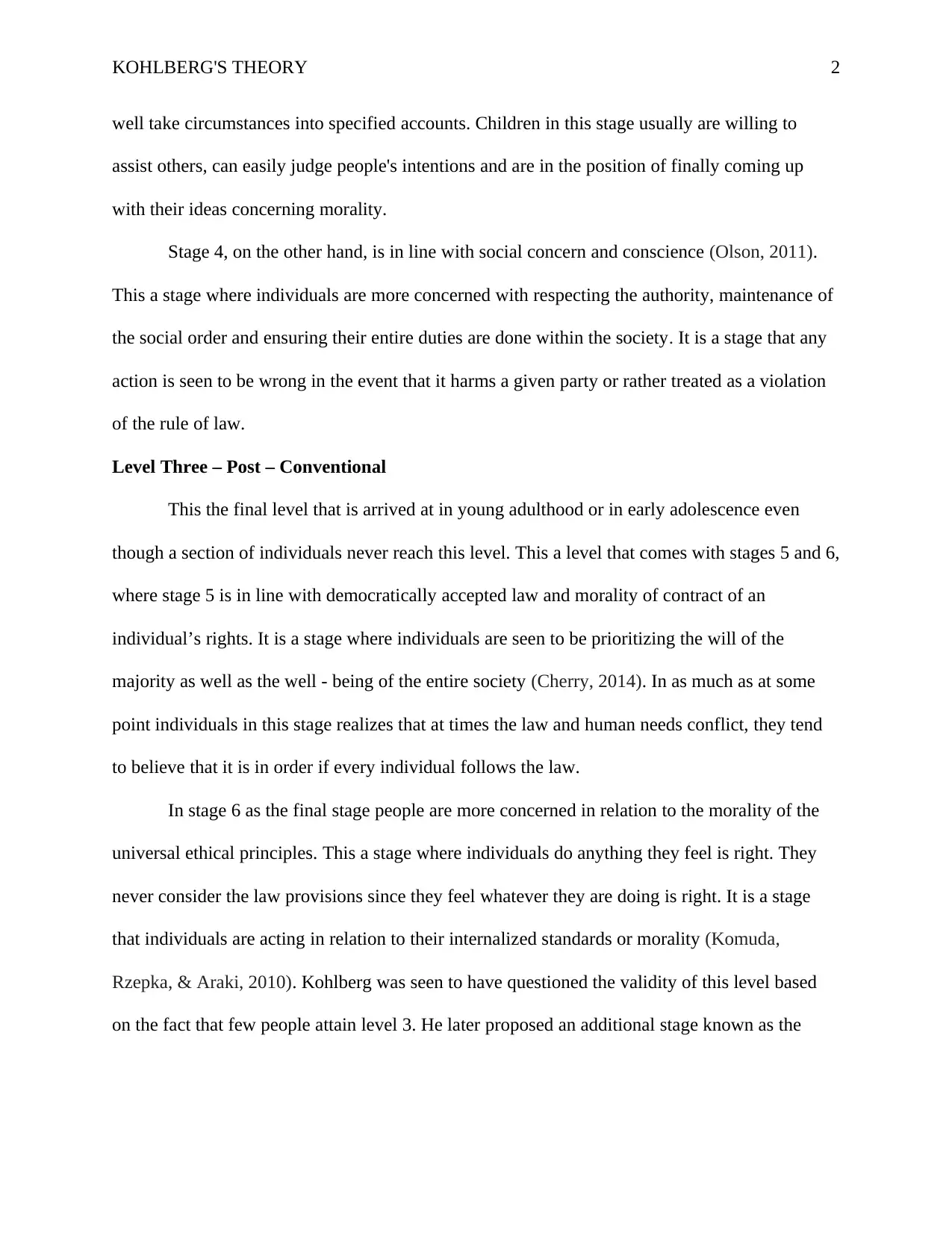
KOHLBERG'S THEORY 2
well take circumstances into specified accounts. Children in this stage usually are willing to
assist others, can easily judge people's intentions and are in the position of finally coming up
with their ideas concerning morality.
Stage 4, on the other hand, is in line with social concern and conscience (Olson, 2011).
This a stage where individuals are more concerned with respecting the authority, maintenance of
the social order and ensuring their entire duties are done within the society. It is a stage that any
action is seen to be wrong in the event that it harms a given party or rather treated as a violation
of the rule of law.
Level Three – Post – Conventional
This the final level that is arrived at in young adulthood or in early adolescence even
though a section of individuals never reach this level. This a level that comes with stages 5 and 6,
where stage 5 is in line with democratically accepted law and morality of contract of an
individual’s rights. It is a stage where individuals are seen to be prioritizing the will of the
majority as well as the well - being of the entire society (Cherry, 2014). In as much as at some
point individuals in this stage realizes that at times the law and human needs conflict, they tend
to believe that it is in order if every individual follows the law.
In stage 6 as the final stage people are more concerned in relation to the morality of the
universal ethical principles. This a stage where individuals do anything they feel is right. They
never consider the law provisions since they feel whatever they are doing is right. It is a stage
that individuals are acting in relation to their internalized standards or morality (Komuda,
Rzepka, & Araki, 2010). Kohlberg was seen to have questioned the validity of this level based
on the fact that few people attain level 3. He later proposed an additional stage known as the
well take circumstances into specified accounts. Children in this stage usually are willing to
assist others, can easily judge people's intentions and are in the position of finally coming up
with their ideas concerning morality.
Stage 4, on the other hand, is in line with social concern and conscience (Olson, 2011).
This a stage where individuals are more concerned with respecting the authority, maintenance of
the social order and ensuring their entire duties are done within the society. It is a stage that any
action is seen to be wrong in the event that it harms a given party or rather treated as a violation
of the rule of law.
Level Three – Post – Conventional
This the final level that is arrived at in young adulthood or in early adolescence even
though a section of individuals never reach this level. This a level that comes with stages 5 and 6,
where stage 5 is in line with democratically accepted law and morality of contract of an
individual’s rights. It is a stage where individuals are seen to be prioritizing the will of the
majority as well as the well - being of the entire society (Cherry, 2014). In as much as at some
point individuals in this stage realizes that at times the law and human needs conflict, they tend
to believe that it is in order if every individual follows the law.
In stage 6 as the final stage people are more concerned in relation to the morality of the
universal ethical principles. This a stage where individuals do anything they feel is right. They
never consider the law provisions since they feel whatever they are doing is right. It is a stage
that individuals are acting in relation to their internalized standards or morality (Komuda,
Rzepka, & Araki, 2010). Kohlberg was seen to have questioned the validity of this level based
on the fact that few people attain level 3. He later proposed an additional stage known as the

KOHLBERG'S THEORY 3
seventh level and named it as the comic stage, a stage where every individual is in the position of
considering the effects of their actions in the public domain.
Explanation of 1 theory towards each Level of Kohlberg Theory.
Level 1 – Pre – Conventional Level & Havighurst’s Developmental Tasks Theory under
Middle childhood.
Havighurst’s Developmental Tasks under Middle Childhood relates to Conventional
Level of Kohlberg theory. The Havighurst’s Developmental Tasks under Middle Childhood is
made of children from the age of 4 – 10 years. It states that this the time that children are
learning various physical skills in relation to playing games, attaining independence,
development of the entire school-related skills such as writing, reading, and counting. Finally is
that they also develop a conscience and various values (Cherry, 2014). The pre-conventional
level also stresses these measures in one way or the other based on their age brackets.
Level 2 - Conventional Level & Piaget's theory of Cognitive development under the Formal
Operations Stage.
Piaget’s theory of Cognitive development under the Formal Operations Stage relates to
Conventional stage of Kohlberg's theory. The Piaget’s Formal operations stage is associated with
children at the ages of 11 and above. The stage states that the children at this age are seen as
becoming capable of more hypothetical, abstract and theoretical reasoning. The children are
better placed as far as the application of various rules in line with different situations is
concerned. It means the children are in the position of differentiating the ethical and unethical
practices. They are then to be making their decision cornering whatever they perceive to be the
best in the society (May, 2017). The same applies to the Kohlberg Conventional stage that
stresses the fact that Children in this stage usually are willing to assist others, can easily judge
seventh level and named it as the comic stage, a stage where every individual is in the position of
considering the effects of their actions in the public domain.
Explanation of 1 theory towards each Level of Kohlberg Theory.
Level 1 – Pre – Conventional Level & Havighurst’s Developmental Tasks Theory under
Middle childhood.
Havighurst’s Developmental Tasks under Middle Childhood relates to Conventional
Level of Kohlberg theory. The Havighurst’s Developmental Tasks under Middle Childhood is
made of children from the age of 4 – 10 years. It states that this the time that children are
learning various physical skills in relation to playing games, attaining independence,
development of the entire school-related skills such as writing, reading, and counting. Finally is
that they also develop a conscience and various values (Cherry, 2014). The pre-conventional
level also stresses these measures in one way or the other based on their age brackets.
Level 2 - Conventional Level & Piaget's theory of Cognitive development under the Formal
Operations Stage.
Piaget’s theory of Cognitive development under the Formal Operations Stage relates to
Conventional stage of Kohlberg's theory. The Piaget’s Formal operations stage is associated with
children at the ages of 11 and above. The stage states that the children at this age are seen as
becoming capable of more hypothetical, abstract and theoretical reasoning. The children are
better placed as far as the application of various rules in line with different situations is
concerned. It means the children are in the position of differentiating the ethical and unethical
practices. They are then to be making their decision cornering whatever they perceive to be the
best in the society (May, 2017). The same applies to the Kohlberg Conventional stage that
stresses the fact that Children in this stage usually are willing to assist others, can easily judge
⊘ This is a preview!⊘
Do you want full access?
Subscribe today to unlock all pages.

Trusted by 1+ million students worldwide
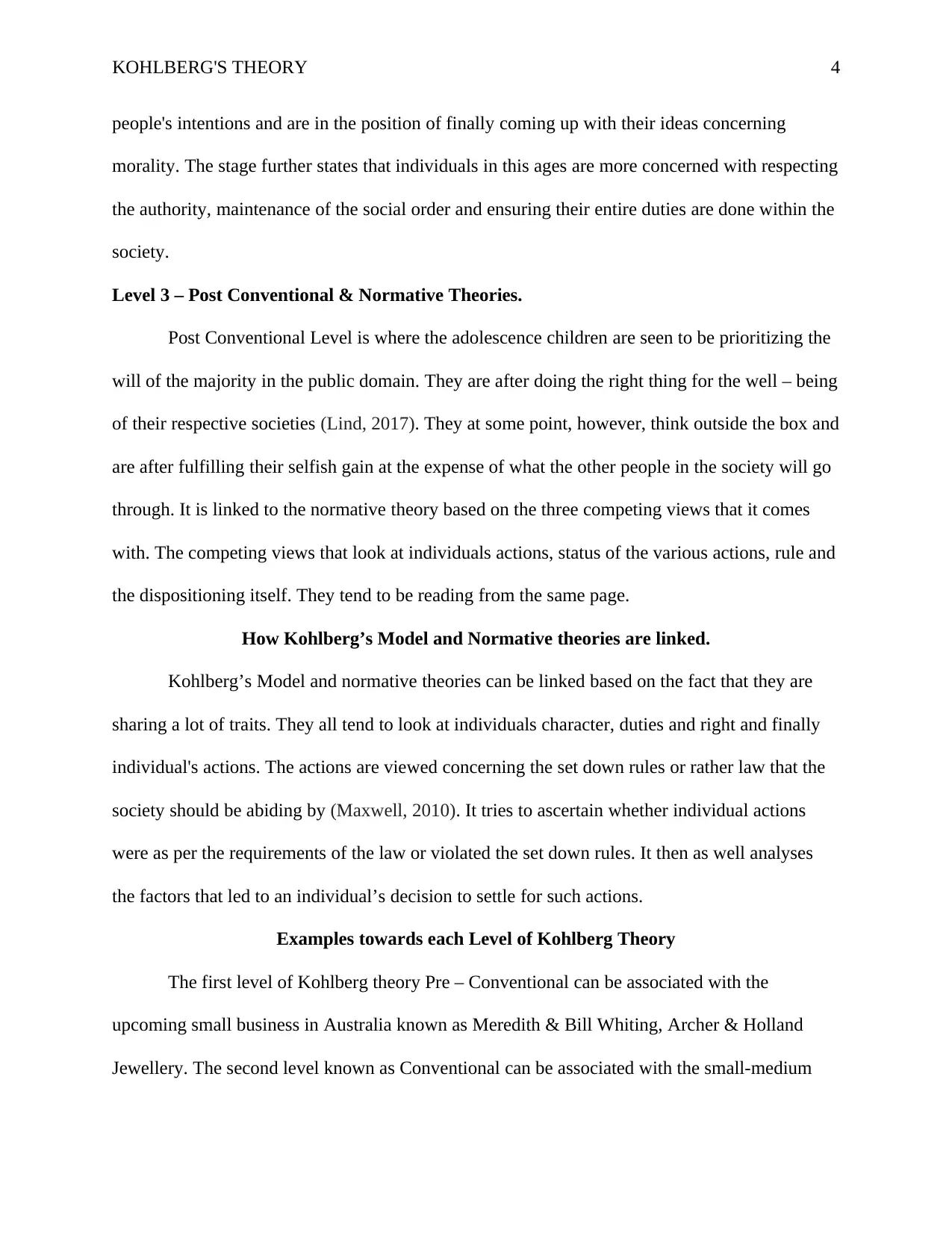
KOHLBERG'S THEORY 4
people's intentions and are in the position of finally coming up with their ideas concerning
morality. The stage further states that individuals in this ages are more concerned with respecting
the authority, maintenance of the social order and ensuring their entire duties are done within the
society.
Level 3 – Post Conventional & Normative Theories.
Post Conventional Level is where the adolescence children are seen to be prioritizing the
will of the majority in the public domain. They are after doing the right thing for the well – being
of their respective societies (Lind, 2017). They at some point, however, think outside the box and
are after fulfilling their selfish gain at the expense of what the other people in the society will go
through. It is linked to the normative theory based on the three competing views that it comes
with. The competing views that look at individuals actions, status of the various actions, rule and
the dispositioning itself. They tend to be reading from the same page.
How Kohlberg’s Model and Normative theories are linked.
Kohlberg’s Model and normative theories can be linked based on the fact that they are
sharing a lot of traits. They all tend to look at individuals character, duties and right and finally
individual's actions. The actions are viewed concerning the set down rules or rather law that the
society should be abiding by (Maxwell, 2010). It tries to ascertain whether individual actions
were as per the requirements of the law or violated the set down rules. It then as well analyses
the factors that led to an individual’s decision to settle for such actions.
Examples towards each Level of Kohlberg Theory
The first level of Kohlberg theory Pre – Conventional can be associated with the
upcoming small business in Australia known as Meredith & Bill Whiting, Archer & Holland
Jewellery. The second level known as Conventional can be associated with the small-medium
people's intentions and are in the position of finally coming up with their ideas concerning
morality. The stage further states that individuals in this ages are more concerned with respecting
the authority, maintenance of the social order and ensuring their entire duties are done within the
society.
Level 3 – Post Conventional & Normative Theories.
Post Conventional Level is where the adolescence children are seen to be prioritizing the
will of the majority in the public domain. They are after doing the right thing for the well – being
of their respective societies (Lind, 2017). They at some point, however, think outside the box and
are after fulfilling their selfish gain at the expense of what the other people in the society will go
through. It is linked to the normative theory based on the three competing views that it comes
with. The competing views that look at individuals actions, status of the various actions, rule and
the dispositioning itself. They tend to be reading from the same page.
How Kohlberg’s Model and Normative theories are linked.
Kohlberg’s Model and normative theories can be linked based on the fact that they are
sharing a lot of traits. They all tend to look at individuals character, duties and right and finally
individual's actions. The actions are viewed concerning the set down rules or rather law that the
society should be abiding by (Maxwell, 2010). It tries to ascertain whether individual actions
were as per the requirements of the law or violated the set down rules. It then as well analyses
the factors that led to an individual’s decision to settle for such actions.
Examples towards each Level of Kohlberg Theory
The first level of Kohlberg theory Pre – Conventional can be associated with the
upcoming small business in Australia known as Meredith & Bill Whiting, Archer & Holland
Jewellery. The second level known as Conventional can be associated with the small-medium
Paraphrase This Document
Need a fresh take? Get an instant paraphrase of this document with our AI Paraphraser

KOHLBERG'S THEORY 5
firm by the name Jolleen Hicks, Aboriginal Insights, WA (Habermas, 2017). Finally the third
stage by the name Post – Conventional can be associated with a firm known as Deloitte
Australia.
Part 2
Which Question Relates to which stage.
First Stage
The first question that relates to this stage is, "what will be the best punishment for
different actions'? The second question may be "did he obey the set rules, or he went against
them"? The question relates to this stage since individuals at this ages obey rules so that they
may not be punished (Lourenço, 2014). Besides they do so to fulfill their selfish gain.
Second Stage
The question that relates to this stage is “what was the reason behind judging others'? The
question relates to this stage since individuals at this ages are very curious; they always want to
ascertain whatever was wrong (Meehan, 2013). They tend to believe in morality and doing the
right thing.
Third Stage
The question that relates to this stage is “what made him settle for such an action”? It
relates to this stage based on the fact that individuals at this age at times are involved in unethical
issues to satisfy their selfish gain (Monga, 2007). They never consider whatever others in public
will be going through.
The stage you belong and the decision you settled for.
You must belong to the third stage that is Post – Conventional. A stage where every party
believes in the rule of law. The parties however at some point decides not to consider the
firm by the name Jolleen Hicks, Aboriginal Insights, WA (Habermas, 2017). Finally the third
stage by the name Post – Conventional can be associated with a firm known as Deloitte
Australia.
Part 2
Which Question Relates to which stage.
First Stage
The first question that relates to this stage is, "what will be the best punishment for
different actions'? The second question may be "did he obey the set rules, or he went against
them"? The question relates to this stage since individuals at this ages obey rules so that they
may not be punished (Lourenço, 2014). Besides they do so to fulfill their selfish gain.
Second Stage
The question that relates to this stage is “what was the reason behind judging others'? The
question relates to this stage since individuals at this ages are very curious; they always want to
ascertain whatever was wrong (Meehan, 2013). They tend to believe in morality and doing the
right thing.
Third Stage
The question that relates to this stage is “what made him settle for such an action”? It
relates to this stage based on the fact that individuals at this age at times are involved in unethical
issues to satisfy their selfish gain (Monga, 2007). They never consider whatever others in public
will be going through.
The stage you belong and the decision you settled for.
You must belong to the third stage that is Post – Conventional. A stage where every party
believes in the rule of law. The parties however at some point decides not to consider the
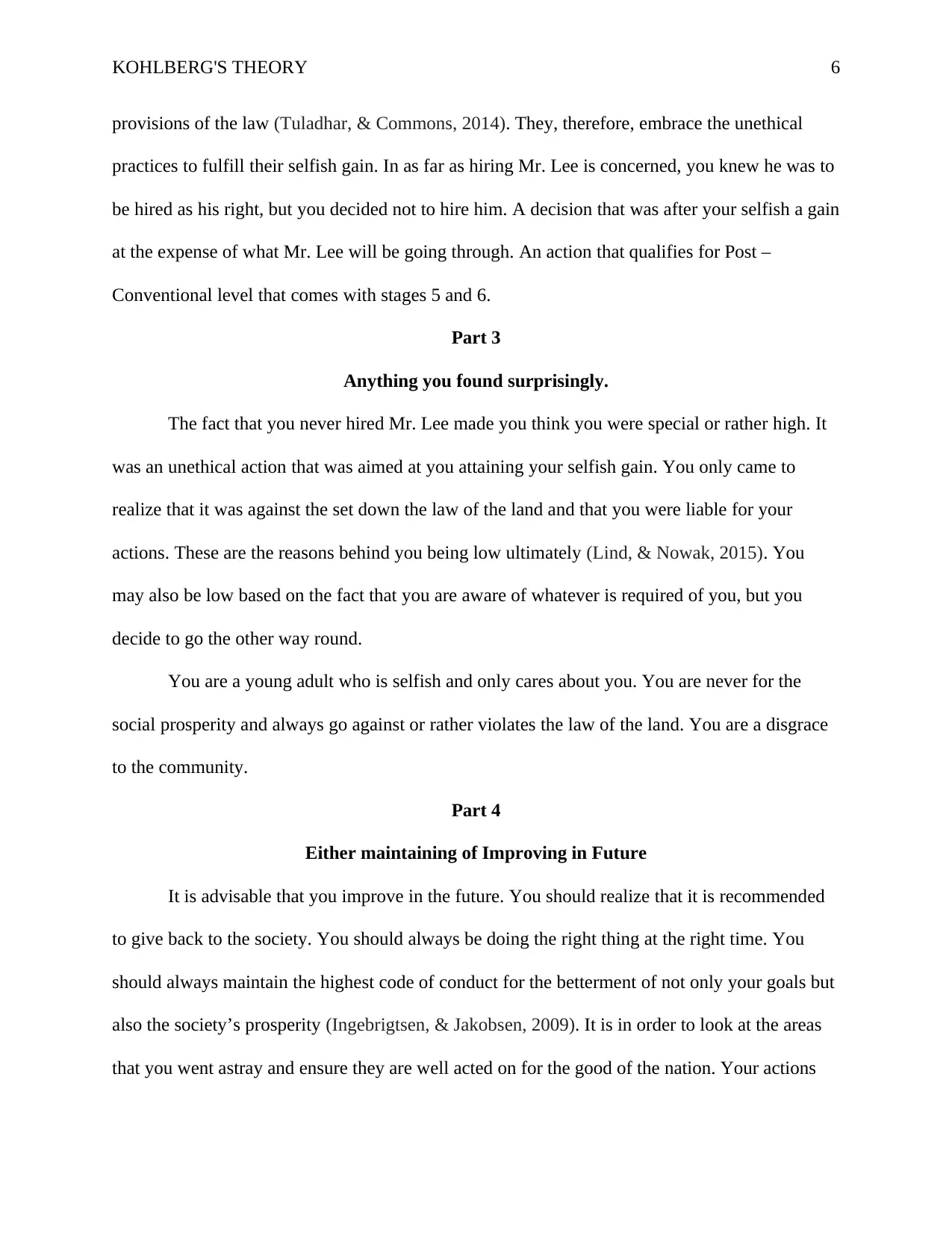
KOHLBERG'S THEORY 6
provisions of the law (Tuladhar, & Commons, 2014). They, therefore, embrace the unethical
practices to fulfill their selfish gain. In as far as hiring Mr. Lee is concerned, you knew he was to
be hired as his right, but you decided not to hire him. A decision that was after your selfish a gain
at the expense of what Mr. Lee will be going through. An action that qualifies for Post –
Conventional level that comes with stages 5 and 6.
Part 3
Anything you found surprisingly.
The fact that you never hired Mr. Lee made you think you were special or rather high. It
was an unethical action that was aimed at you attaining your selfish gain. You only came to
realize that it was against the set down the law of the land and that you were liable for your
actions. These are the reasons behind you being low ultimately (Lind, & Nowak, 2015). You
may also be low based on the fact that you are aware of whatever is required of you, but you
decide to go the other way round.
You are a young adult who is selfish and only cares about you. You are never for the
social prosperity and always go against or rather violates the law of the land. You are a disgrace
to the community.
Part 4
Either maintaining of Improving in Future
It is advisable that you improve in the future. You should realize that it is recommended
to give back to the society. You should always be doing the right thing at the right time. You
should always maintain the highest code of conduct for the betterment of not only your goals but
also the society’s prosperity (Ingebrigtsen, & Jakobsen, 2009). It is in order to look at the areas
that you went astray and ensure they are well acted on for the good of the nation. Your actions
provisions of the law (Tuladhar, & Commons, 2014). They, therefore, embrace the unethical
practices to fulfill their selfish gain. In as far as hiring Mr. Lee is concerned, you knew he was to
be hired as his right, but you decided not to hire him. A decision that was after your selfish a gain
at the expense of what Mr. Lee will be going through. An action that qualifies for Post –
Conventional level that comes with stages 5 and 6.
Part 3
Anything you found surprisingly.
The fact that you never hired Mr. Lee made you think you were special or rather high. It
was an unethical action that was aimed at you attaining your selfish gain. You only came to
realize that it was against the set down the law of the land and that you were liable for your
actions. These are the reasons behind you being low ultimately (Lind, & Nowak, 2015). You
may also be low based on the fact that you are aware of whatever is required of you, but you
decide to go the other way round.
You are a young adult who is selfish and only cares about you. You are never for the
social prosperity and always go against or rather violates the law of the land. You are a disgrace
to the community.
Part 4
Either maintaining of Improving in Future
It is advisable that you improve in the future. You should realize that it is recommended
to give back to the society. You should always be doing the right thing at the right time. You
should always maintain the highest code of conduct for the betterment of not only your goals but
also the society’s prosperity (Ingebrigtsen, & Jakobsen, 2009). It is in order to look at the areas
that you went astray and ensure they are well acted on for the good of the nation. Your actions
⊘ This is a preview!⊘
Do you want full access?
Subscribe today to unlock all pages.

Trusted by 1+ million students worldwide
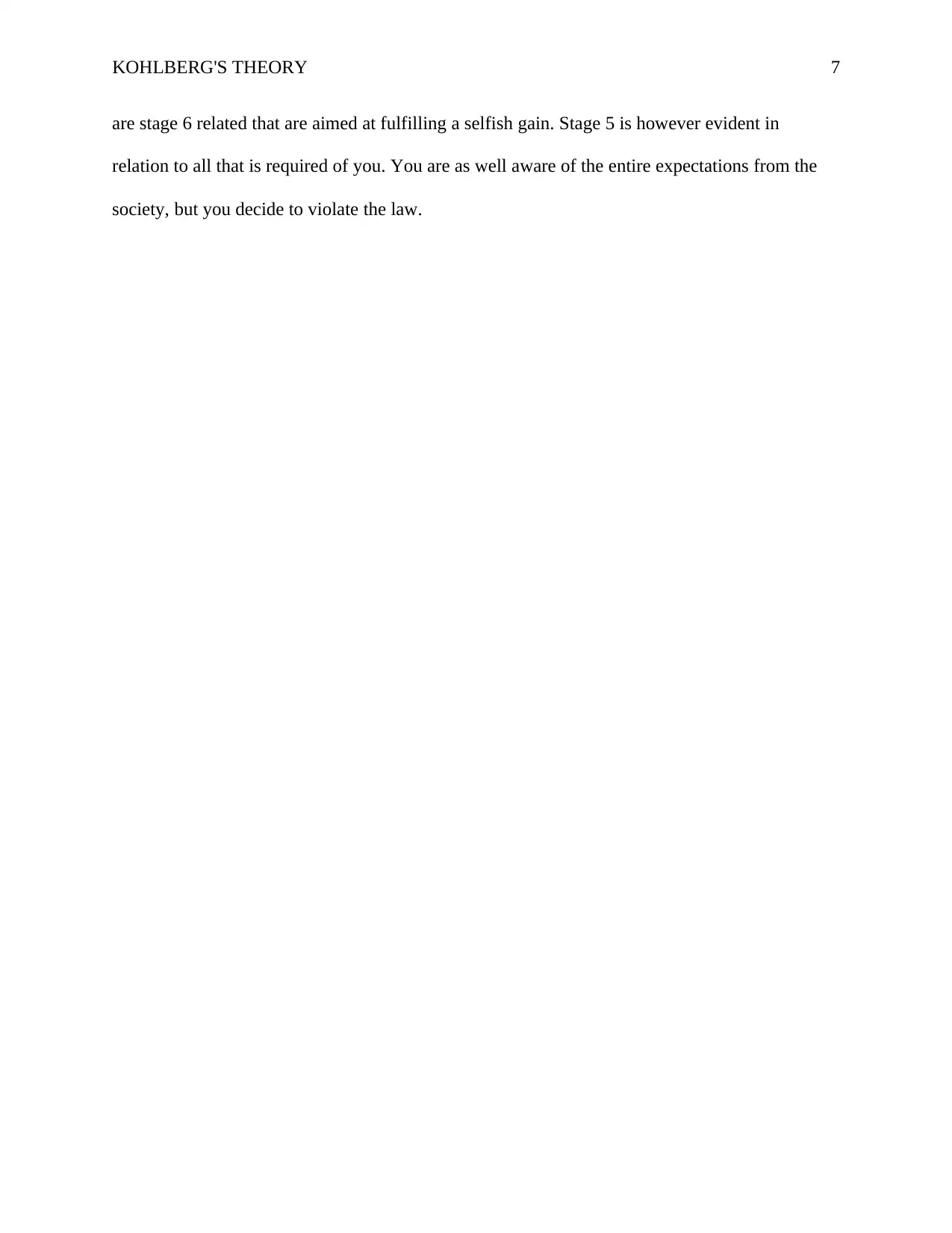
KOHLBERG'S THEORY 7
are stage 6 related that are aimed at fulfilling a selfish gain. Stage 5 is however evident in
relation to all that is required of you. You are as well aware of the entire expectations from the
society, but you decide to violate the law.
are stage 6 related that are aimed at fulfilling a selfish gain. Stage 5 is however evident in
relation to all that is required of you. You are as well aware of the entire expectations from the
society, but you decide to violate the law.
Paraphrase This Document
Need a fresh take? Get an instant paraphrase of this document with our AI Paraphraser
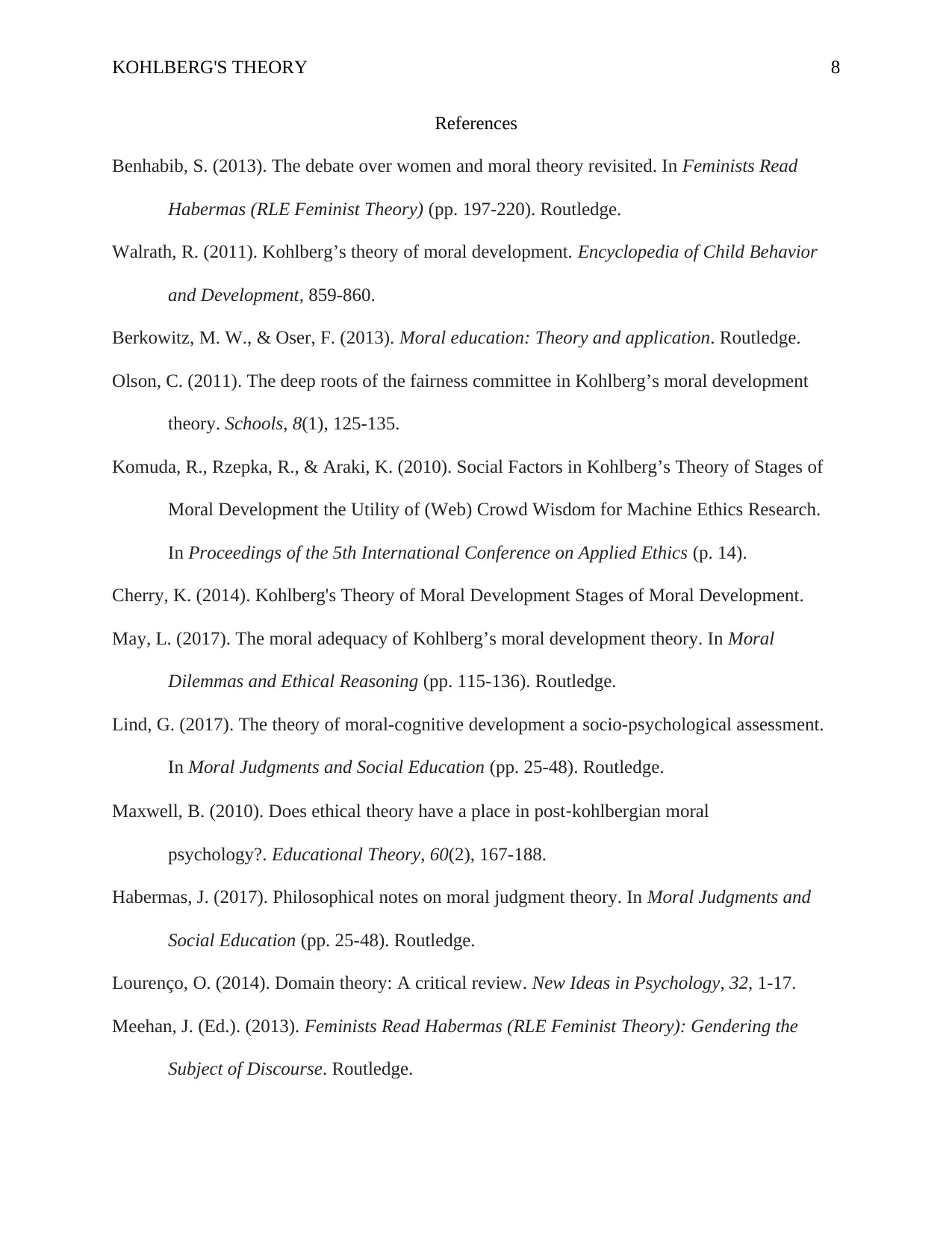
KOHLBERG'S THEORY 8
References
Benhabib, S. (2013). The debate over women and moral theory revisited. In Feminists Read
Habermas (RLE Feminist Theory) (pp. 197-220). Routledge.
Walrath, R. (2011). Kohlberg’s theory of moral development. Encyclopedia of Child Behavior
and Development, 859-860.
Berkowitz, M. W., & Oser, F. (2013). Moral education: Theory and application. Routledge.
Olson, C. (2011). The deep roots of the fairness committee in Kohlberg’s moral development
theory. Schools, 8(1), 125-135.
Komuda, R., Rzepka, R., & Araki, K. (2010). Social Factors in Kohlberg’s Theory of Stages of
Moral Development the Utility of (Web) Crowd Wisdom for Machine Ethics Research.
In Proceedings of the 5th International Conference on Applied Ethics (p. 14).
Cherry, K. (2014). Kohlberg's Theory of Moral Development Stages of Moral Development.
May, L. (2017). The moral adequacy of Kohlberg’s moral development theory. In Moral
Dilemmas and Ethical Reasoning (pp. 115-136). Routledge.
Lind, G. (2017). The theory of moral-cognitive development a socio-psychological assessment.
In Moral Judgments and Social Education (pp. 25-48). Routledge.
Maxwell, B. (2010). Does ethical theory have a place in post‐kohlbergian moral
psychology?. Educational Theory, 60(2), 167-188.
Habermas, J. (2017). Philosophical notes on moral judgment theory. In Moral Judgments and
Social Education (pp. 25-48). Routledge.
Lourenço, O. (2014). Domain theory: A critical review. New Ideas in Psychology, 32, 1-17.
Meehan, J. (Ed.). (2013). Feminists Read Habermas (RLE Feminist Theory): Gendering the
Subject of Discourse. Routledge.
References
Benhabib, S. (2013). The debate over women and moral theory revisited. In Feminists Read
Habermas (RLE Feminist Theory) (pp. 197-220). Routledge.
Walrath, R. (2011). Kohlberg’s theory of moral development. Encyclopedia of Child Behavior
and Development, 859-860.
Berkowitz, M. W., & Oser, F. (2013). Moral education: Theory and application. Routledge.
Olson, C. (2011). The deep roots of the fairness committee in Kohlberg’s moral development
theory. Schools, 8(1), 125-135.
Komuda, R., Rzepka, R., & Araki, K. (2010). Social Factors in Kohlberg’s Theory of Stages of
Moral Development the Utility of (Web) Crowd Wisdom for Machine Ethics Research.
In Proceedings of the 5th International Conference on Applied Ethics (p. 14).
Cherry, K. (2014). Kohlberg's Theory of Moral Development Stages of Moral Development.
May, L. (2017). The moral adequacy of Kohlberg’s moral development theory. In Moral
Dilemmas and Ethical Reasoning (pp. 115-136). Routledge.
Lind, G. (2017). The theory of moral-cognitive development a socio-psychological assessment.
In Moral Judgments and Social Education (pp. 25-48). Routledge.
Maxwell, B. (2010). Does ethical theory have a place in post‐kohlbergian moral
psychology?. Educational Theory, 60(2), 167-188.
Habermas, J. (2017). Philosophical notes on moral judgment theory. In Moral Judgments and
Social Education (pp. 25-48). Routledge.
Lourenço, O. (2014). Domain theory: A critical review. New Ideas in Psychology, 32, 1-17.
Meehan, J. (Ed.). (2013). Feminists Read Habermas (RLE Feminist Theory): Gendering the
Subject of Discourse. Routledge.

KOHLBERG'S THEORY 9
Monga, M. (2007). Managers' moral reasoning: Evidence from large Indian manufacturing
organizations. Journal of business ethics, 71(2), 179-194.
Tuladhar, C. T., & Commons, M. L. (2014). Correspondence between some life-span, stage
theory developmental sequences of stages and levels. Behavioral Development
Bulletin, 19(3), 24.
Lind, G., & Nowak, E. (2015). Kohlberg’s Unnoticed Dilemma—The External Assessment of
Internal Moral Competence?. In Kohlberg Revisited (pp. 139-153). Brill Sense.
Ingebrigtsen, S., & Jakobsen, O. (2009). Moral development of the economic actor. Ecological
Economics, 68(11), 2777-2784.
Monga, M. (2007). Managers' moral reasoning: Evidence from large Indian manufacturing
organizations. Journal of business ethics, 71(2), 179-194.
Tuladhar, C. T., & Commons, M. L. (2014). Correspondence between some life-span, stage
theory developmental sequences of stages and levels. Behavioral Development
Bulletin, 19(3), 24.
Lind, G., & Nowak, E. (2015). Kohlberg’s Unnoticed Dilemma—The External Assessment of
Internal Moral Competence?. In Kohlberg Revisited (pp. 139-153). Brill Sense.
Ingebrigtsen, S., & Jakobsen, O. (2009). Moral development of the economic actor. Ecological
Economics, 68(11), 2777-2784.
⊘ This is a preview!⊘
Do you want full access?
Subscribe today to unlock all pages.

Trusted by 1+ million students worldwide
1 out of 9
Related Documents
Your All-in-One AI-Powered Toolkit for Academic Success.
+13062052269
info@desklib.com
Available 24*7 on WhatsApp / Email
![[object Object]](/_next/static/media/star-bottom.7253800d.svg)
Unlock your academic potential
Copyright © 2020–2025 A2Z Services. All Rights Reserved. Developed and managed by ZUCOL.





